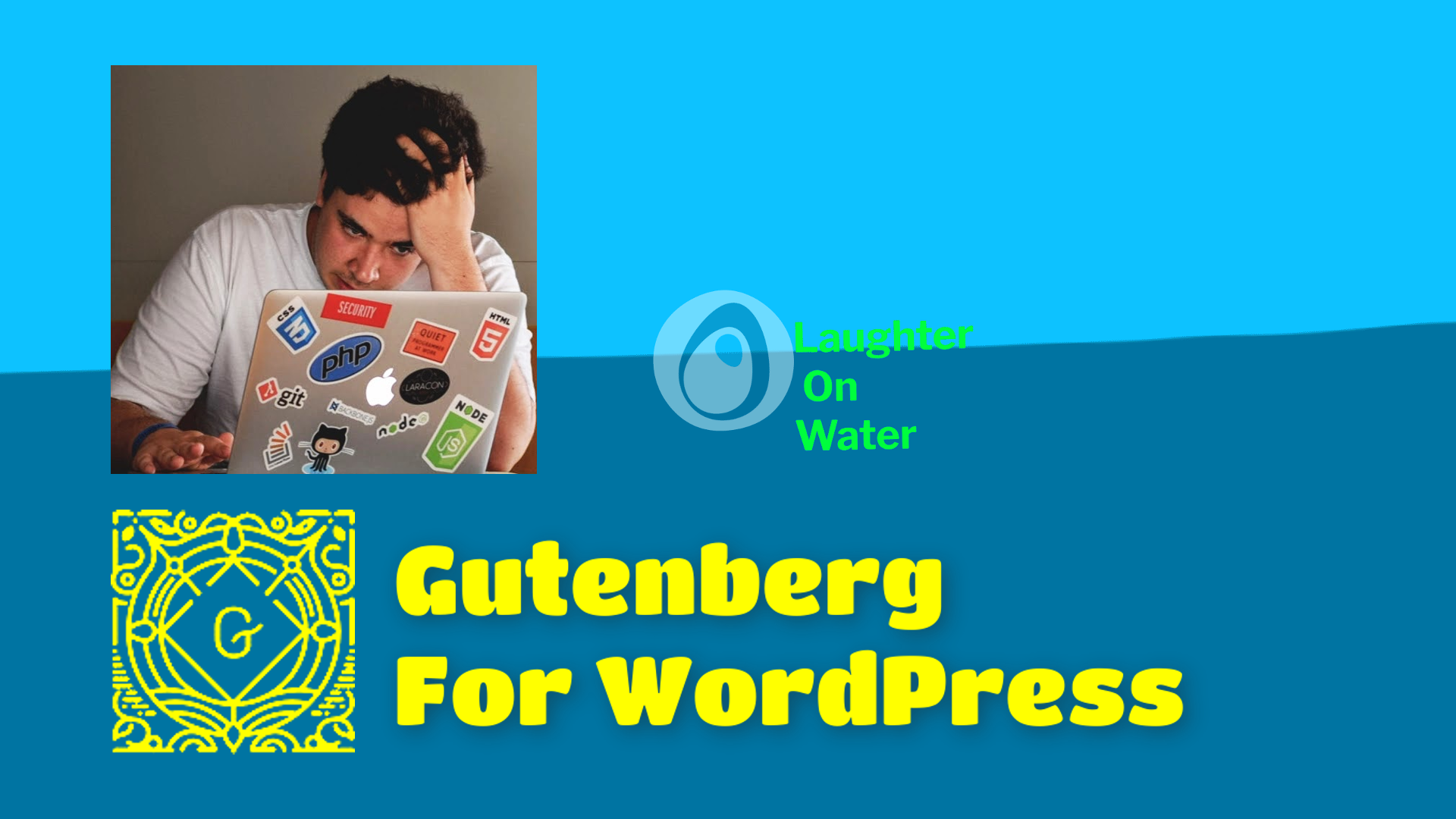Gutenberg for WordPress – Promising but Frustrating
I have a love-hate relationship with WordPress’s Gutenberg project. Hi, this is Chris with Laughter On Water. In this episode, I’ll explain my take on the future of Gutenberg for WordPress.
Gutenberg is named after the inventor of the printing press, Johannes Gutenberg. Groups of moveable type were arranged into blocks and those blocks were arranged on a press. So it’s entirely appropriate that the components of WordPress’s Gutenberg project are called blocks. Blocks are assembled one after the other. Each block offers curated components like paragraphs, images, galleries, video and more. When I say curated, I mean that each block has special features that can be tweaked on a per-block basis. This can be useful for creating emphasis and drawing attention to preferred content.
WordPress is already attractive because it appeals to multiple audiences at various skill levels. If you want a free wordpress site and aren’t interested in learning how to create plugins or themes, the platform allows you to create compelling content without having to spend a lot of time learning the interface. If you want to learn a little more, you can edit a theme or even create a plugin. Because it’s open-source, if you have the skills, you can even help develop WordPress core with thousands of other volunteers. WordPress is used for small and heavily trafficked sites alike. It improves continually, and remains a valuable freely-available content management system. Wix and SquareSpace are proprietary, with a monetary hurdle that WordPress doesn’t require.
Gutenberg is likely a direct response to proprietary web platforms like Wix and SquareSpace — most especially SquareSpace. Wix is still a bit like the Wild West, but SquareSpace may be a threat because of its smoothly curated and very attractive block design. SquareSpace uses curated components that are also called blocks that provide much the same capability.
However, there are trade-offs when moving from a document-based editor to one that’s block-based. As a blogger, the document-based method is easier to write long columns of text occasionally peppered with video or images. It’s easier to cut and paste whole swaths of content and paste them somewhere else. When you view the document-model as text-only, the simplicity of its construction is clear. When you view the block model as text only in Gutenberg, you are limited to viewing text-only from a single block at a time.
WordPress’s lead developers have a vision of the platform becoming blocks-only by year 2022. Everything about WordPress 5 and later clearly steers existing users toward the Gutenberg interface. If you’re still using the Classic editor, you’re going to see the Gutenberg Nag. But the majority of WordPress sites were begun prior to Gutenberg. Some existing plugins create templates that approximate blocks using alternative methods. Other sites have created proprietary or in-house plugins and components that drastically alter the capabilities of WordPress, making them poorly suited for integration with the Gutenberg interface.
I like that the Gutenberg interface is available. But frankly, I want the choice of whether to use Gutenberg or Classic text editing. More than that, I want that choice to continue past 2022.
According to it’s own website, Classic Editor is one of the most active plugin installs in the history of wordpress. Unfortunately, the classic editor plugin is also built to actively funnel users toward the Gutenberg editor whether we like it or not. So there are alternative plugins that may help.
Before that, let’s explore Classic Editor, created by members of WordPress core team in response to people like me who have been flagrantly Gutenberg-averse. If you or one of your admins mistakenly enables Gutenberg on a post, it’s a terrible chore to try reverse the post back to Classic Editor format, especially if you have no previous revisions for the post. The plugin page also suggests that it will no longer be supported after 2022. I suppose core coders would prefer that all WordPress users be compliant by that time. I don’t see this happening willingly, so I looked for alternative plugins to classic editor.
One alternative is called Disable Gutenberg. It disables the nag screen and allows you a modicum of granularity as to which pages or posts use Gutenberg. You can allow only certain roles to have Classic Editor, or just posts but not pages. You can also disable Gutenberg by post id or template and allow the choice of whether to edit in Gutenberg or Classic editor in the content list.
A second alternative is Classic Editor Addon, which has no settings, but performs a complete reversal more uniformly back to the original pre-WordPress 5.0 version of the classic editor.
A third alternative is TinyMCE Advanced. This plugin has been around forever and has consistently allowed a better editing experience for WordPress users who create reams of text directly in the WordPress interface. TinyMCE Advanced has become entirely Gutenberg compatible, offering the ability to have what they call classic text blocks instead of having a block for each paragraph. So you could create a whole block of normal classic text, and then when you want a cover photo or a gallery, you just add it before or after the classic block. Then you can start a new classic editor block just like any other block. Classic editor blocks can post media, headers and everything else you’ve come to expect in a classic text interface. It’s an astonishingly simple solution that hybridizes the desires of those who want to edit in classic text and those who want to edit in blocks. There are two caveats:
If you ever convert a fiendishly long Classic block to Gutenberg blocks, you can’t go back. Every paragraph is now a separate block.
If you ever disable the TinyMCE Advanced plugin and start editing a post with the regular Gutenberg interface, it will throw errors, and you’ll have to leave the post without saving or convert the entire page to normal Gutenberg blocks.
The nice thing about TinyMCE Advanced though is that it has a robust support history on WordPress.org, so it will hopefully be around for a good while longer. The only improvement that I could suggest for TinyMCE Advanced classic blocks, is that if I attempt to convert a classic block into Gutenberg blocks, a popup modal alert should ask me for confirmation with a button press. This block type should be integrated into Gutenberg core.
I want the best of both worlds. When I’m blogging, I don’t want to be hampered because every paragraph is a separate block. Blocks are more tedious to manipulate as a group. But I also want to be able to scatter in a few Gutenberg blocks because they are impressive and look great on any screen size. I really like the cover photo blocks. I like the ability to color the background of specific paragraphs. What’s even more exciting are the blocks are becoming available from third-party plugin coders on wordpress.org. I look forward to learning which of them may end up also being integrated into Gutenberg core.
I’m looking forward to a community effort where WordPress includes both the classic editor capabilities and the new Gutenberg blocks.


 Rarely in the
Rarely in the 
 I recently got an email from my friend warning about pending doom coming from a computer virus. There’s a copy of it in the blockquote below.
I recently got an email from my friend warning about pending doom coming from a computer virus. There’s a copy of it in the blockquote below.